
 |
|
|
#1 |
|
Member
Join Date: Dec 2004
Location: Sint-Amandsberg (near Ghent, Belgium)
Posts: 830
|
I found this knife yesterday at a big antique market in Brugge (Belgium). The man who sold it to me knew very little about this weapon. He was told it came from Africa. He sold it together with a spear blade which was in fact a keris blade. So I don't think his information is very accurate.
The knife is forged in the same way as many African knives are forged. There is no actual middlerib. The blade seems to consist of two halves put together. In fact, it's made in one piece, but it looks that way. A lot of African blade are made in this fashion. This could mean it's from Africa. What tribe or what region, I don't know. Probably a region where there was a big Arabic influence. Could even be Congo...?  On the other hand, as it was found together with a keris blade, it could also be Indonesian in origin. I know that jambiya type knives were found in Sumatra. If someone has any suggestion, that would be great.  The knife measures 37 cm. The handle is 9,5 cm long and made of wood. It has some carved decoration. At the top of the handle, the 'butt' consists of a small roll of metal. The size of the handle is too small to fit comfortably in my (European) hand. The blade is sharp on both sides. 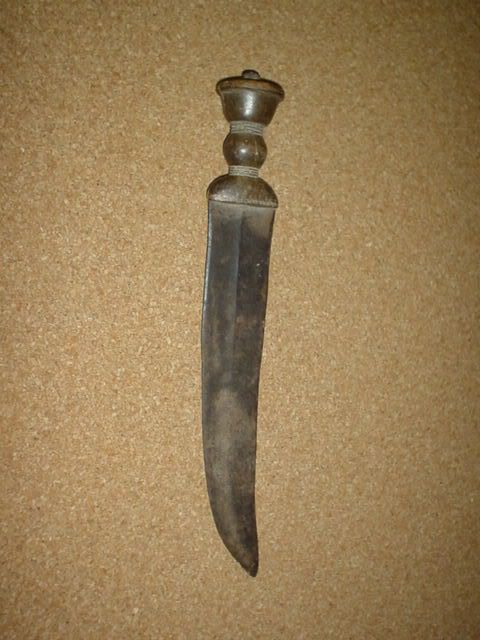 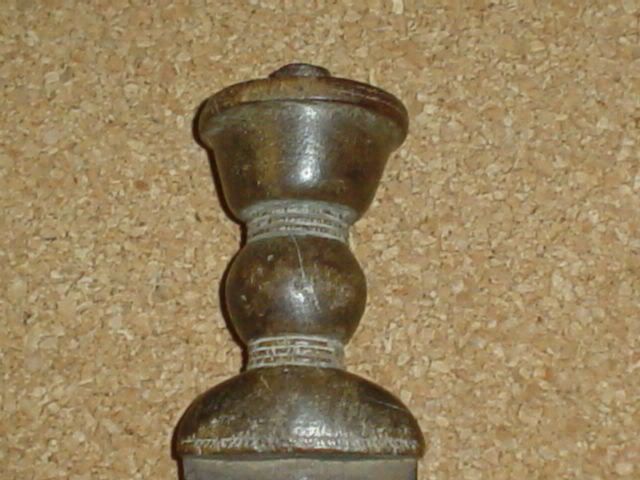 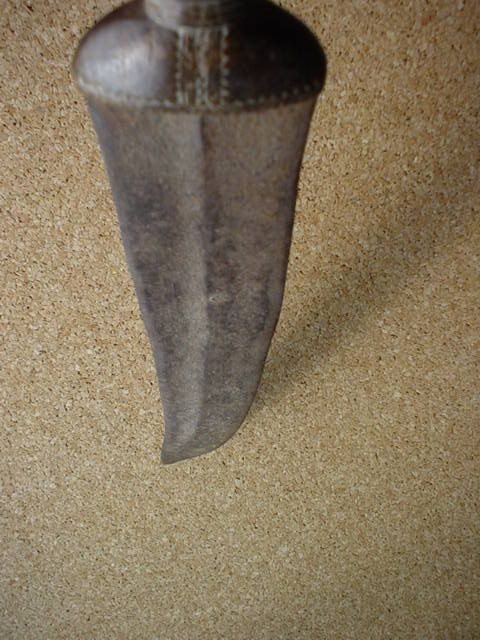 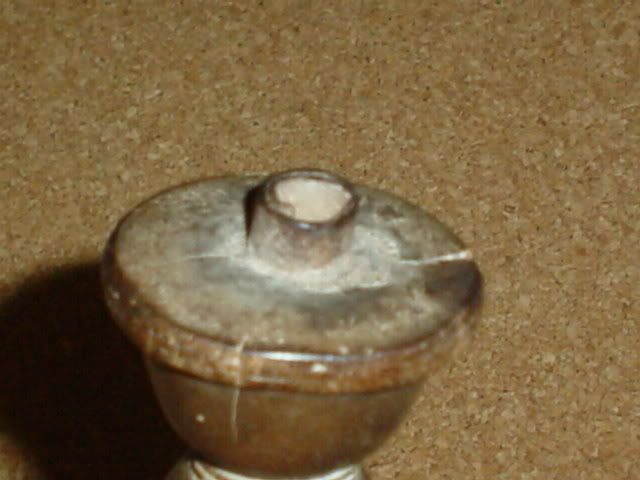
|
|
|

|
|
|
#2 |
|
Member
Join Date: Dec 2004
Location: Sweden
Posts: 1,637
|
It doesn't look at all like an Indonesian Jambiya to me anyway.
Michael |
|
|

|
|
|
#3 |
|
Member
Join Date: Dec 2004
Location: What is still UK
Posts: 5,922
|
Looks African to me. The handle reminds me of many congo knives. The forge work looks very much like that of Massi spears. It could have influences from the eastern congo and west from Arab east Africa like Mombasa. I really like the decoration on the handle. Tim
|
|
|

|
|
|
#4 |
|
Member
Join Date: Apr 2005
Posts: 3,255
|
I'd second that - hilt doesn't look SE Asian at all.
|
|
|

|
|
|
#5 |
|
Member
Join Date: Dec 2004
Location: The Netherlands
Posts: 1,209
|
It could be very well a beladau. The sumatran or kalimantan jambiya. It is my first thought when I saw this one.
I'm not very good in the african region,but my feeling tells me that it hasn't the african look. And when it came with a keris blade..... It could be the remains of a bring back collection of a deceased relative. |
|
|

|
|
|
#6 |
|
Member
Join Date: Dec 2004
Location: What is still UK
Posts: 5,922
|
I think this African. Look at this Massi metalwork, three different spears but distinctive African metalwork. Tim
|
|
|

|
|
|
#7 |
|
Member
Join Date: Dec 2004
Location: Sweden
Posts: 1,637
|
Henk,
I have now checked Van Z, Gardner and Holstein (don't have Hill yet and Draeger usually is a bit distorted with the illustrations). All the reference Beladau I found has a more curved blade (like a jambiya). They also have another kind of hilt (U-top/"crown" instead of knob as well as another form of the gripping part). I only found one Kalimantan Jambiya (Holstein) but it also had the same blade as the others and a more "Kalimantan-flowery" hilt. Do you have any other reference pictures? Michael |
|
|

|
|
|
#8 |
|
Member
Join Date: Apr 2005
Posts: 3,255
|
Hi Henk,
I'm ready to eat my words but that hilt doesn't ring a bell with me. What ethnic group would employ this or a similar hilt configuration? This example looks much more main-stream: http://www.oriental-arms.com/item.php?id=60. Regards, Kai |
|
|

|
|
|
#9 |
|
Member
Join Date: Dec 2004
Location: Sint-Amandsberg (near Ghent, Belgium)
Posts: 830
|
Thanks for all the input, guys. But the knife's origin still isn't clear to me. Judging from the way the blade is constructed, I still feel inclined to think it's from Africa. But I'm really not sure.
Here's another pic of the hilt. I noticed that I showed the back of the handle. The front has some more decoration. Someone suggested Kuba, because of the geometrical decoration. 
|
|
|

|
|
|
#10 |
|
Member
Join Date: Dec 2004
Location: What is still UK
Posts: 5,922
|
Interesting picture, there is a superficial similarity of metalwork on the blade. I would say that the handle form and decoration, particularly in its simplicity was African. Tim
Last edited by Tim Simmons; 28th September 2005 at 05:44 PM. Reason: better wording |
|
|

|
|
|
#11 |
|
Member
Join Date: Dec 2004
Location: The Netherlands
Posts: 1,209
|
Michael,
I don't have any other reference pictures. Sorry! And for Kai, it was just my first thought at the first picture together with Freddy's remark that it was brought in with a keris. So that was my throw for a beladau. It has a bit the look of a jambiya like dagger and varying forms are not uncommon. Besides that I have seen other surprising hiltforms from the archipello. The last picture of the hilt however looks like those african decorations we often see. But I think Tim or the other Africa experts are able to judge that better. |
|
|

|
|
|
#12 |
|
Member
Join Date: Dec 2004
Location: Sweden
Posts: 1,637
|
Henk,
I fully agree that variations are quite common and my question for reference pictures was only out of curiosity to learn something new. Michael |
|
|

|
|
|
#13 |
|
Member
Join Date: Dec 2004
Location: The Netherlands
Posts: 1,209
|
Michael,
I wished I could show you some pics. But unfortunately....... |
|
|

|
|
|
#14 |
|
Member
Join Date: Dec 2004
Location: Europe
Posts: 2,718
|
I donít know from where it comes, but let me add another area Ė South India. I his book Hindu Arms and Ritual, Robert Elgood shows stone sculptures, where the hilts could look like the one shown here.
|
|
|

|
|
|
#15 |
|
Member
Join Date: Dec 2004
Location: Sint-Amandsberg (near Ghent, Belgium)
Posts: 830
|
Good remark, Jens
Tim said East Africa, so an Indian influence is also possible. I looked at some of my knives and I found other 'jambiya-type' pieces. All from Africa, but from different regions. 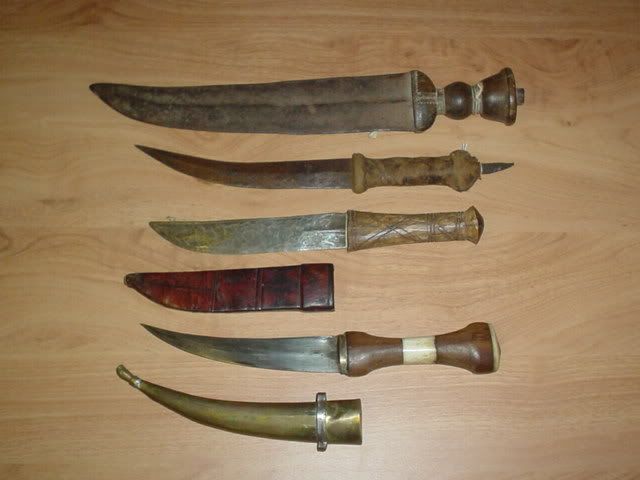 The top one is the one we are discussing. The second from the top is probably from the Sudan. Then the one with red leather sheath comes from Mali. The bottom one probably originates in North Africa. |
|
|

|
|
|
#16 |
|
Member
Join Date: Dec 2004
Location: What is still UK
Posts: 5,922
|
I really like the graduation of styles shown like that, the top two are rather nice. Tim
|
|
|

|
|
|
#17 |
|
Member
Join Date: Dec 2004
Location: Europe
Posts: 2,718
|
Hi Freddy,
I donít say it is from south India, what I am saying is, that types like that were used there in the early times. As has been mentioned, trade from the east coast of Africa to India, and many other places in the area, was intense very early, so influence is not out of the question. The sculptures Robert Elgood shows are from 15th, 16th and 17th century Ė if I remember right. It is in its own right a strange hilt, rather big but short. On the other hand, I imagine that one would have a good grip at a hilt like that. Nice layout you show. |
|
|

|
 |
| Thread Tools | Search this Thread |
| Display Modes | |
|
|